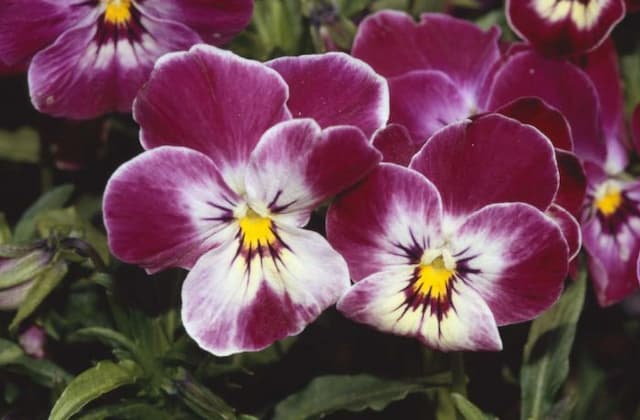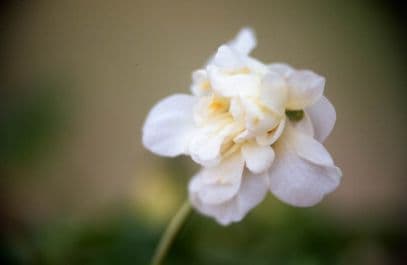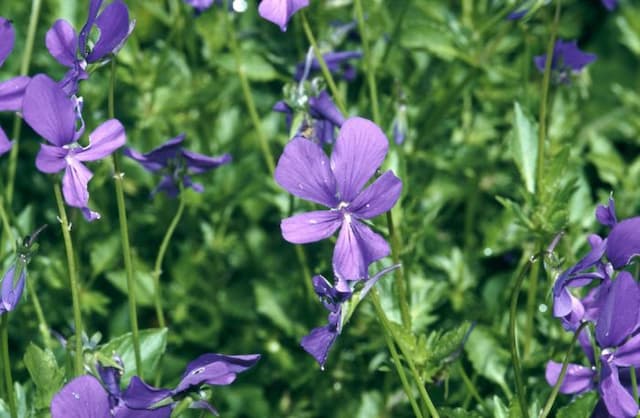Horned violet Viola cornuta Alba Group (C)

ABOUT
The Viola cornuta Alba Group, commonly referred to as the Horned Violet, is known for its distinctive and appealing appearance. It boasts a lush green foliage that serves as a backdrop for its captivating flowers. Each flower exhibits a delicate and pristine white color, contributing to its standout presence in a garden setting. The petals are velvety to the touch and often possess a slightly overlapping arrangement, which adds to the fullness of the bloom. The Horned Violet's flowers culminate in a characteristic spur, which is suggestive of the "horned" aspect of its common name, lending an elegant and somewhat whimsical shape to the flower. The leaves are typically heart-shaped, broad, and with subtle veining, which may be more prominent depending on the light and surrounding environment conditions. Together, these features create a charming and graceful aesthetic, making this plant a favorite among gardeners seeking to add a touch of serenity and purity to their floral arrangements or garden spaces.
About this plant
 Names
NamesFamily
Violaceae
Synonyms
Horned Violet, Tufted Pansy, Horned Pansy
Common names
Viola cornuta Alba Group.
 Toxicity
ToxicityTo humans
Horned violet (Viola cornuta Alba Group) is considered non-toxic to humans. There are no significant toxic effects reported from ingesting parts of this plant.
To pets
Horned violet (Viola cornuta Alba Group) is also generally regarded as non-toxic to pets. It should not cause any serious symptoms of poisoning if ingested by animals such as cats and dogs.
 Characteristics
CharacteristicsLife cycle
Perennials
Foliage type
Semi-evergreen
Color of leaves
Green
Flower color
White
Height
6-10 inches (15-25 cm)
Spread
6-12 inches (15-30 cm)
Plant type
Herb
Hardiness zones
4-9
Native area
Spain
Benefits
 General Benefits
General Benefits- Aesthetic Appeal: Viola cornuta Alba Group, also known as Horned Pansy, offers a visually appealing addition to gardens with its delicate, white flowers, enhancing the beauty of landscaping projects.
- Versatility in Landscaping: Horned Pansy can be used in a variety of settings such as borders, rock gardens, or containers due to its compact size and shape.
- Extended Blooming Season: With proper care, Horned Pansy can provide a long blooming season, offering flowers from spring through fall in some climates.
- Attracts Pollinators: The flowers of Horned Pansy can attract pollinators like bees and butterflies, contributing to the health of your garden ecosystem.
- Low Maintenance: Horned Pansy is known for being low maintenance, requiring minimal care once established, making it a good choice for gardeners of all skill levels.
- Hardy Nature: This plant is relatively hardy and can withstand cooler temperatures, which allows for early spring and late fall planting in many regions.
- Variety of Uses: Horned Pansy is not only a garden plant but can also be used in floral arrangements and as an edible garnish, thanks to its attractive and safe-to-eat flowers.
- Ground Cover: Because of its spreading habit, Horned Pansy can be used as a ground cover to help suppress weeds and cover bare spots in the garden.
- Psychological Wellbeing: The mere presence of Horned Pansy with its vibrant flowers can enhance psychological wellbeing by adding a sense of calm and joy to a garden space.
- Seasonal Color: Horned Pansy can provide seasonal color to gardens, particularly in spring when its bright flowers stand out against the landscape.
 Medical Properties
Medical PropertiesThis plant is not used for medical purposes.
 Air-purifying Qualities
Air-purifying QualitiesThis plant is not specifically known for air purifying qualities.
 Other Uses
Other Uses- Viola cornuta, commonly known as Horned Violet, can be used in floral arrangements due to its attractive flowers and ability to add a delicate touch to bouquets.
- In edible landscaping, the Horned Violet's flowers can be used to ornamentally enhance vegetable gardens or permaculture landscapes as they are edible and can provide aesthetic appeal.
- The flowers of the Horned Violet can be used to create natural dyes for textiles, offering hues that range from soft purples to blues depending on the mordant used.
- These plants can serve as a living mulch, suppressing weeds and maintaining soil moisture when planted densely in garden beds.
- The Horned Violet can be used in sensory gardens due to its varied textures and gentle fragrance, adding an interactive experience.
- In culinary use, the flowers can be crystallized with sugar and used as elegant decorations for desserts and pastries.
- The plant is used as a ground cover to stabilize soil on slopes or in areas prone to erosion due to its spreading habit.
- Its vibrant flowers can be frozen in ice cubes to create visually stunning additions to cold beverages or decorative ice buckets.
- They can be a natural pest deterrent in the garden as some pests tend to avoid the Horned Violet due to its scent.
- As a cold-tolerant plant, the Horned Violet can extend the flowering season in a garden, offering color and interest in early spring or late fall when other plants may not be in bloom.
Interesting Facts
 Feng Shui
Feng ShuiThe Horned Pansy is not used in Feng Shui practice.
 Zodiac Sign Compitability
Zodiac Sign CompitabilityThe Horned Pansy is not used in astrology practice.
 Plant Symbolism
Plant Symbolism- Innocence: The delicate white blossoms of the horned pansy signify purity and innocence.
- Remembrance: As with many flowers, horned pansies are associated with the idea of remembrance and can be used to signify fond memories.
- Loving Thoughts: The horned pansy often represents loving or thoughtful feelings towards someone.
- Humble Charm: Despite its modest appearance, the horned pansy can symbolize a quiet and unassuming beauty or charm.
 Water
WaterHorned violet plants should be watered deeply whenever the top inch of soil feels dry to the touch, which could be approximately once or twice a week, depending on climate conditions. Ensure that the soil is evenly moistened but not waterlogged. When you water, do so early in the morning to allow foliage to dry out over the day, reducing the risk of fungal diseases. Typically, they might require around 1-2 gallons of water each week during active growth periods in spring and summer. During cooler seasons or rainy weather, reduce the amount accordingly to avoid overwatering.
 Light
LightHorned violets prefer partial shade but can tolerate full sun in cooler climates. The best spot for these plants would be one where they receive morning sunlight and shade during the hottest part of the day. They thrive in an area that is bright without receiving direct, harsh afternoon sun, which can scorch their leaves and flowers.
 Temperature
TemperatureHorned violets flourish in cooler temperatures and can survive in temperatures as low as the mid-20s Fahrenheit. They grow best at temperatures between 40°F and 70°F. These plants can handle a light frost, but prolonged exposure to temperatures below 25°F or above 80°F can be detrimental to their health.
 Pruning
PruningPruning horned violets is essential to encourage bushy growth and prolong the flowering period. Deadhead spent flowers regularly throughout the growing season to promote further blooming. Cut back the foliage in late fall or early winter to tidy up the plant and prepare it for the next growing season. Pruning is best done with clean, sharp shears.
 Cleaning
CleaningAs needed
 Soil
SoilHorned violet prefers well-draining soil rich in organic matter, with a pH range of 6.0 to 6.5 for optimal growth. A mix of garden soil, peat moss, and perlite or sand can create a suitable environment that retains moisture while allowing excess water to drain.
 Repotting
RepottingHorned violets generally don’t require frequent repotting and can thrive in the same pot for several years. It's best to repot only when the plant becomes root-bound or the soil is exhausted, typically every 2 to 3 years.
 Humidity & Misting
Humidity & MistingHorned violet thrives best in moderate humidity levels, typical of outdoor conditions, and does not require any special humidity adjustments when grown inside the average home.
 Suitable locations
Suitable locationsIndoor
Ensure bright, indirect light and cool temperatures for indoor horned violets.
Outdoor
Plant horned violets in partial shade, protect from hot afternoon sun.
Hardiness zone
4-8 USDA
 Life cycle
Life cycleViola cornuta Alba Group, commonly known as Horned Violet or Horned Pansy, starts its life as a seed, usually planted in the spring or autumn, depending on the climate. Upon germination, the seedling emerges, developing roots and a set of true leaves, establishing itself as a young plant. The plant then enters a vegetative growth phase, during which it produces a rosette of heart-shaped leaves and begins to develop its root system further. Following the vegetative stage, the Horned Violet reaches maturity and begins its flowering phase, where white or off-white flowers with a pansy-like appearance bloom, typically in late spring to summer. After pollination, often by insects, the flowers produce fruit in the form of capsules containing seeds, which when mature, are dispersed by environmental factors or human intervention. The plant can then enter a period of dormancy, particularly in colder regions, to survive adverse conditions before the cycle starts anew with the next growing season.
 Propogation
PropogationPropogation time
Spring to Summer
Propogation: The Viola cornuta Alba Group, commonly known as Horned Violet 'Alba', is most frequently propagated through seed. This method is popular due to its simplicity and effectiveness. Propagation from seed typically begins in late winter or early spring, often around February or March. To propagate Horned Violet 'Alba' by seed, the seeds should be sown in flats or pots using a well-draining seed-starting mix. Lightly cover the seeds with soil, as they require darkness to germinate. Maintain the soil moisture and keep the flats or pots at a temperature of around 65 to 70 degrees Fahrenheit (18-21 degrees Celsius) for optimal germination. Once seedlings have developed their first true leaves, they can be transplanted into individual containers or into the garden when the danger of frost has passed.









